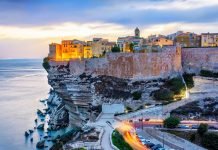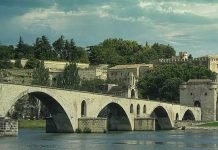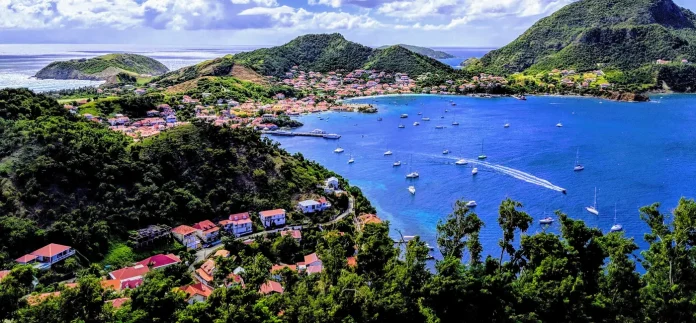Located in the heart of the Caribbean, Guadeloupe is a captivating French overseas region that beckons sophisticated travelers seeking a unique blend of vibrant culture, fascinating history, and stunning natural scenery.
Guadeloupe is located in the Leeward Islands in the northern part of the Lesser Antilles, which is a partly volcanic island arc. It is situated about 150 miles (240 km) to the northwest, lying to the northwest of the outer arc of the Lesser Antilles.
Historical Footprints
The roots of Guadeloupe are steeped in a rich and turbulent history. From the original Arawak inhabitants to the era of European colonization and slavery, the island’s past is palpable. Visit the Mémorial ACTe in Pointe-à-Pitre, a museum dedicated to the memory of the slave trade, which provides a powerful and enlightening experience.
Arawak Origins and Carib Arrival
Before European contact, Guadeloupe was inhabited by the Arawak people, a peaceful and agricultural society. In the 15th century, the Caribs, known for their fierce warrior traditions, arrived from South America and gradually displaced the Arawaks. Their legacy is deeply imprinted on the island’s culture, particularly through place names and some persisting traditions.
European Colonization
Christopher Columbus sighted Guadeloupe in 1493, but it was the French who began to settle the island in the 17th century. Initially claimed by Charles Liénard de l’Olive and Jean Duplessis d’Ossonville in 1635, Guadeloupe became a focal point in the fierce competition between European powers for colonial influence in the Caribbean.
The Era of Slavery
To cultivate sugar cane plantations, which became the backbone of the island’s economy, European colonizers imported enslaved Africans in large numbers. Guadeloupe became a prominent hub in the trans-Atlantic slave trade. Slavery was abolished in 1848, primarily due to the relentless advocacy of Victor Schœlcher, a French politician and abolitionist, and the local resistance of enslaved individuals.
Political Turmoil and World Wars
Throughout the 18th and 19th centuries, control of Guadeloupe changed hands multiple times between the French and the British, reflecting the broader geopolitical struggles of these European powers. During the World Wars, Guadeloupe played a strategic role due to its location. In World War II, it initially aligned with Vichy France but later joined the Free French Forces under Charles de Gaulle.
Path to Departmentalization
In 1946, Guadeloupe officially became an overseas department of France, fundamentally altering its political and social structure. This development brought French citizenship to the inhabitants and sought to integrate Guadeloupe more deeply into the French state. Despite the benefits of this change, such as access to social welfare and healthcare, departmentalization also generated a significant degree of political and social tension, as debates about autonomy and identity took center stage.
Contemporary Reflections
Today, the complex history of Guadeloupe is a subject of reflection and discussion among its inhabitants. The Mémorial ACTe museum in Pointe-à-Pitre stands as a tribute to the memory of slavery and the slave trade. It is a world-class facility that tells a poignant and necessary story through its exhibits. The architecture of the museum itself, resembling a silvered box resting on a foundation evocative of a sugar factory, symbolizes the island’s historical ties to slavery and the sugar industry.
In the broader landscape of Guadeloupe, ruins of sugar mills and plantations, forts, and colonial buildings serve as constant reminders of the island’s layered history. They stand as silent witnesses to the trials and resilience of the people who have called, and continue to call, Guadeloupe home.
By engaging with these sites, sophisticated travelers are offered a profound connection to Guadeloupe’s past, granting a deeper understanding of the island’s present-day culture and society.
Cultural Vibrance
Guadeloupe’s culture is a captivating blend of French and Creole influences. Its festivities, such as Carnaval and Fête des Cuisinières, showcase the island’s rich cultural tapestry through music, dance, and culinary traditions.
The Melody of Creole Music
In Guadeloupe, music is more than just entertainment; it is an expression of the island’s soul. Genres such as Gwo Ka, Zouk, and Kadans are deeply rooted in Guadeloupe’s heritage. Gwo Ka, in particular, is a traditional form of music and dance that originated with the enslaved Africans brought to Guadeloupe. It involves percussive rhythms played on a set of drums known as Ka, and UNESCO has recognized it as a form of intangible cultural heritage.
The Color and Spirit of Carnaval
Carnaval is one of the most anticipated events in Guadeloupe’s cultural calendar. It begins in January and reaches its peak in February with a grand parade. During this period, the island pulses with vibrant colors, intricate costumes, and rhythmic beats. Participants, called Carnavaliers, dance through the streets of towns and cities, embodying various characters that reflect the island’s history and culture.
Fête des Cuisinières: A Culinary Tribute
Every August, Guadeloupe pays homage to its culinary traditions with the Fête des Cuisinières, or Festival of Women Cooks. This event is a grand celebration of Creole cuisine and the women who have mastered it. Participants, dressed in traditional Creole attire complete with colorful headscarves and aprons, parade through the streets and later gather to bless their utensils in a church ceremony. The festival culminates in a grand feast where mouth-watering dishes such as colombo de poulet (chicken curry) and accras de morue (saltfish fritters) are shared.
Craftsmanship and Artistry
The people of Guadeloupe are renowned for their craftsmanship. From intricate madras fabric (a brightly colored, plaid-patterned material) used in traditional dress to stunning works of pottery in the village of Saint-Jean, the island’s artisans create beautiful, tangible representations of their culture. These crafts are more than just souvenirs; they are pieces of Guadeloupe’s soul, shaped by the hands of its people.
Language: A Reflection of History
While French is the official language, Creole is the heart language of the locals. A rich, expressive language that emerged during the colonial period, Creole is a blend of French with African, Amerindian, and other influences. It stands as a testament to the island’s complex history and the resilience and adaptability of its people.
Theatrical and Literary Scene
Guadeloupe has a vibrant literary and theatrical scene, with numerous local playwrights and authors gaining international recognition. Maryse Condé, for instance, is a celebrated author whose works explore themes of cultural identity and the legacy of colonialism. Her novel Segu is acclaimed worldwide.
Spiritual Tapestry
Guadeloupe’s spiritual life is a blend of Catholicism, inherited from French colonization, and Afro-Caribbean beliefs, a legacy of the island’s African heritage. This rich spiritual tapestry is evident in the island’s many churches and the more traditional léwoz ceremonies, which are musical gatherings deeply rooted in Guadeloupe’s African past
Environmental Wonders
Guadeloupe’s diverse landscapes range from the lush rainforests of Basse-Terre to the sun-kissed beaches of Grande-Terre. The Guadeloupe National Park, a UNESCO Biosphere Reserve, boasts an extensive network of trails through tropical forests, past cascading waterfalls and up the slopes of La Soufrière volcano.
Political Landscape
As an integral part of France, Guadeloupe’s political structure is closely tied to that of its European parent. It holds a unique position as both a region and a department of France. This relationship with France is a key aspect of daily life and is evident in the island’s institutions and services.
Architectural Charm
Explore the unique blend of Creole cottages, French Colonial structures, and modern Caribbean architecture in cities like Basse-Terre and Pointe-à-Pitre. The Fort Fleur d’Épée in Grande-Terre, built in the 18th century, is a standout example of military architecture.
A Respite for the Soul
For those seeking relaxation, Guadeloupe’s numerous white and black sand beaches, such as Plage de la Caravelle and Plage de Malendure, provide perfect settings for unwinding and rejuvenating the spirit.
Culinary Excursions
Guadeloupe is a gastronome’s paradise. With its French culinary roots intertwined with Creole, African, and Indian influences, meals are a delight. Be sure to savor local specialties like Colombo de poulet (chicken curry) and fresh seafood dishes.
Walks and Trails
Walking enthusiasts will find joy in Guadeloupe’s numerous trails. The Trace des Alizés on Basse-Terre is a favored path, weaving through diverse landscapes from the coast to the mountains.
Diving into Blue Depths
For underwater enthusiasts, Guadeloupe is a premier diving destination. The Réserve Cousteau is renowned for its vibrant marine life, including colorful coral reefs, schools of tropical fish, and historic shipwrecks.
Adventure Awaits
Beyond diving and walking, Guadeloupe offers a wide array of adventure sports, including windsurfing at Sainte-Anne and canyoning in the waterfalls of Carbet Falls. For a unique experience, try kite surfing in the lagoons of Grand Cul-de-Sac Marin.
Suggested 7-day tourist itinerary for a visitor to Guadeloupe
Day 1: Pointe-à-Pitre
- Explore the vibrant capital city of Guadeloupe, Pointe-à-Pitre.
- Visit the local markets, such as Marché Saint-Antoine, to experience the vibrant atmosphere and sample local produce.
- Discover the historical sites, including the Schoelcher Museum and the Cathedral of Saint-Pierre and Saint-Paul.
Day 2: Port-Louis / North of Grande Terre
- Head to Port-Louis, a charming coastal town known for its beautiful beaches.
- Enjoy water activities like swimming, snorkeling, or simply relaxing on the sandy shores.
- Explore the nearby natural attractions, such as the Anse Bertrand cliffs and the Pointe de la Grande Vigie.
Day 3: The Pointe des Châteaux / Saint-François / Sainte-Anne
- Visit the Pointe des Châteaux, a stunning peninsula with breathtaking views and unique rock formations.
- Explore the town of Saint-François, known for its marina and golf course.
- Relax on the beautiful beaches of Sainte-Anne and indulge in delicious local cuisine.
Day 4: Basse-Terre
- Venture to Basse-Terre, the western part of Guadeloupe known for its lush rainforests and natural wonders.
- Explore the Parc National de la Guadeloupe, home to the iconic La Soufrière volcano and stunning waterfalls like Cascade aux Ecrevisses.
- Visit the Carbet Falls, a series of three waterfalls nestled in the tropical rainforest.
Day 5: Îles des Saintes
- Take a day trip to the Îles des Saintes, a picturesque archipelago off the coast of Guadeloupe.
- Explore the charming village of Terre-de-Haut and enjoy panoramic views from Fort Napoléon.
- Relax on the pristine beaches and snorkel in the crystal-clear waters.
Day 6: La Soufrière
- Embark on a hike to the summit of La Soufrière, an active volcano and the highest peak in the Lesser Antilles.
- Experience the unique volcanic landscape and enjoy panoramic views of the island.
- Don’t forget to bring appropriate hiking gear and check for any safety advisories.
Day 7: Basse-Terre town and Departure
- Spend the day exploring Basse-Terre town, the capital of the Basse-Terre region.
- Visit the Cathedral of Our Lady of Guadeloupe and stroll through the charming streets lined with colonial architecture.
- Take some time to shop for souvenirs and enjoy a final meal of delicious Creole cuisine.
- Depart from Guadeloupe with wonderful memories of your 7-day adventure.
Please note that this itinerary is a suggestion and can be customized based on your preferences and interests.


















